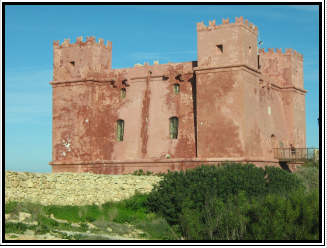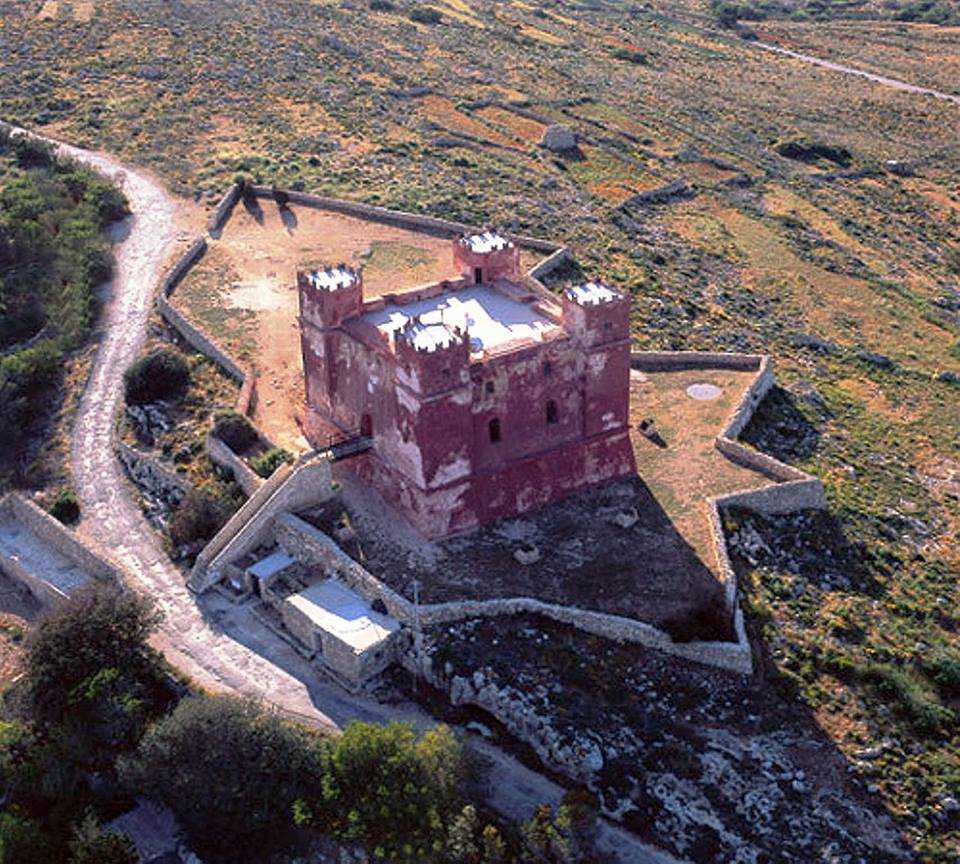The Red Tower
The Red Tower or Fort St. Agatha was one of the seven towers built by Grand Master Lascaris. These towers were proposed by the military engineers Blaise Francoise, Comte de Pagan and his assistant Blondel des Croisettes. In 1645, during the start of the War of Candia, a Venetian colony besieged by the Turks, Lascaris and his council discussed the issue and stressed the necessity to build a large tower over the Saline Vecchie on the place known as il Burgio. The Red Tower was designed and built by Captain Antonio Garsin, a French military engineer working in Malta.
Fort St. Agatha is the largest tower to be built in the village. Although the military engineers were French, it seems that Italian military influence still predominated in Malta. A number of large towers were built on this Island, which served to protect vulnerable bays from Turkish or Barbary corsair attacks. Other large towers were built in different parts of Malta, including Santa Marija Tower on Comino.

The façade of the Red Tower where you have to enter via a flight of steps.

The Red Tower have four bastioned corner similar to the ones built in Spain and Sicily.
Fort St. Agatha was probably in the same site where the first Maltese historian Gian Francesco Abela said that by 1647 il Burgio lay in ruins and that in the past centuries there was the edifice of a tower.
There are two reasons why this area in Mellieħa was chosen. The first was that it had a good command of the approaches of Mellieħa Bay and the ability to defend it. The second was that from that area it would maintain communications between Gozo/Comino and Mdina. It also had the advantage of a good view of enemy shipping passing the straits between Malta and Gozo or troops attempting to disembark in Northern Mellieħa. Therefore it could send an alarm to Mdina to advise that an enemy force was sighted.
The tower’s construction was financed by the Universita of Imdina, and the first stone was laid in 1647 and completed on the 20th November 1648. As I said before, this fortification which in fact was a large tower, its design is square and in its corners has four turrets. The tower consists of a number of stairs and a large central door, which during the Knights was defended by a drawbridge. After entering the door there are two rooms in the ground floor, which houses the only rooms in the tower.

The interior of the tower taken from the inside balcony.

The Red Tower have four bastioned corner similar to the ones built in Spain and Sicily.
Fort St. Agatha was probably in the same site where the first Maltese historian Gian Francesco Abela said that by 1647 il Burgio lay in ruins and that in the past centuries there was the edifice of a tower.
Fort St. Agatha was the second tower to be built at Mellieha and like the Ghajn Tuffieha one was built in an area, probably in the same site where il-Mahras maintained a watch-post. This watch-post is listed in the Militia List of 1417.1 There are two reasons why this area in Mellieha was chosen. The first was that it had a good command of the approaches of Mellieha Bay and the ability to defend it. The second was that from that area it would maintain communications between Gozo/Comino and Imdina. It also had the advantage of a good view of enemy shipping passing the straits between Malta and Gozo or troops attempting to disembark in Northern Mellieha. Therefore it could send an alarm to Imdina to advise that an enemy force was sighted.
The tower’s construction was financed by the Universita of Imdina, and the first stone was laid in 1647 and completed on the 20th November 1648. As I said before, this fortification which in fact was a large tower, its design is square and in its corners has four turrets. The tower consists of a number of stairs and a large central door, which during the Knights was defended by a drawbridge. After entering the door there are two rooms in the ground floor, which houses the only rooms in the tower. 2


The tower’s construction was financed by the Universita of Imdina, and the first stone was laid in 1647 and completed on the 20th November 1648. As I said before, this fortification which in fact was a large tower, its design is square and in its corners has four turrets. The tower consists of a number of stairs and a large central door, which during the Knights was defended by a drawbridge. After entering the door there are two rooms in the ground floor, which houses the only rooms in the tower.
In the past there was a spiral staircase, but when the tower was restored by Din L-Art Ħelwa it was fitted with a winding-staircase which leads one to the roof where guns were installed. On the back side of the Red Tower there is a low star shaped gun platform where a number of cannons were installed there. The first artillery was installed a year later in 1649. During the General Alarm of 1722, while the Order of St. John’s War Council decided to withdraw all the bronze artillery from the smaller towers and coastal batteries so that these could be easily abandoned in case of attack, it strengthened Fort St. Agatha. The latter tower had forty soldiers under one sergeant and it was armed with five cannons, apart from other smaller arms. Fort St. Agatha was painted red, thus referring to its other name Red Tower, because it was much easier for the guards at Naxxar and Mdina to identify it without much difficulty. On top of its entrance a placate was fixed. It says:
D.O.M BELLICIS MARTY:AGATHA VBERIB CLYPEATA HIC STO TURRIS INTERRITA FIDA MEIS HOSTIB MINAX ORBI NOTA SVB AUSPICIIS MAG.MAC. IO PAVLI LASCHARIS CASTELLAR ET F BALTHASSARIS DE MANDOLX SENESCALI CONSVLIBVS IO VINCENTIO CASTELLETTA GREGORIO MAMO MAGRO CASSAR FERDINANDO ANASTASI ANNO SAL. MDCXLIX
References:
1 Stanley Fiorini. “Id-Dejma, il-Mahras and the defence of the Maltese islands in the late medieval and early modern times”, George Cassar (ed), Sacra Militia Issue 2 May 2003, Five Star Printing Design Ltd, Malta, 2003, p 20
2 Stephen Spiteri. Fortresses of the Cross: Hospitaller Military Architecture (1136-1798), A Heritage Interpretation Services Publication, Malta, 1994, p 492
3 Ibid.
Researched and Written by: Charles Debono B.A.(Hons) History